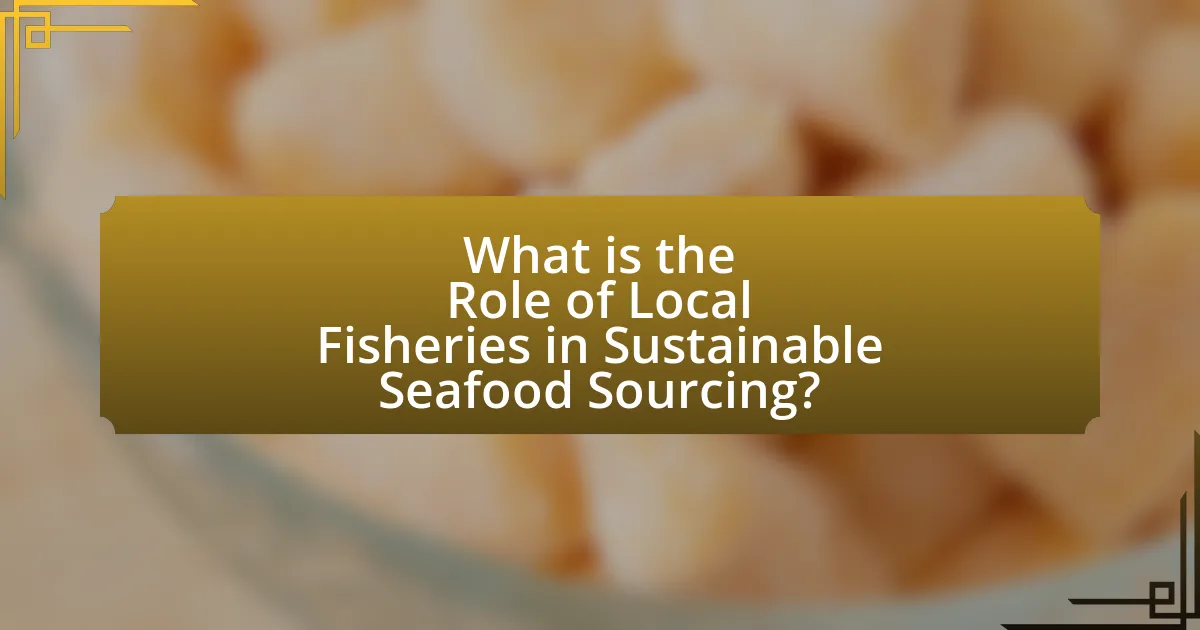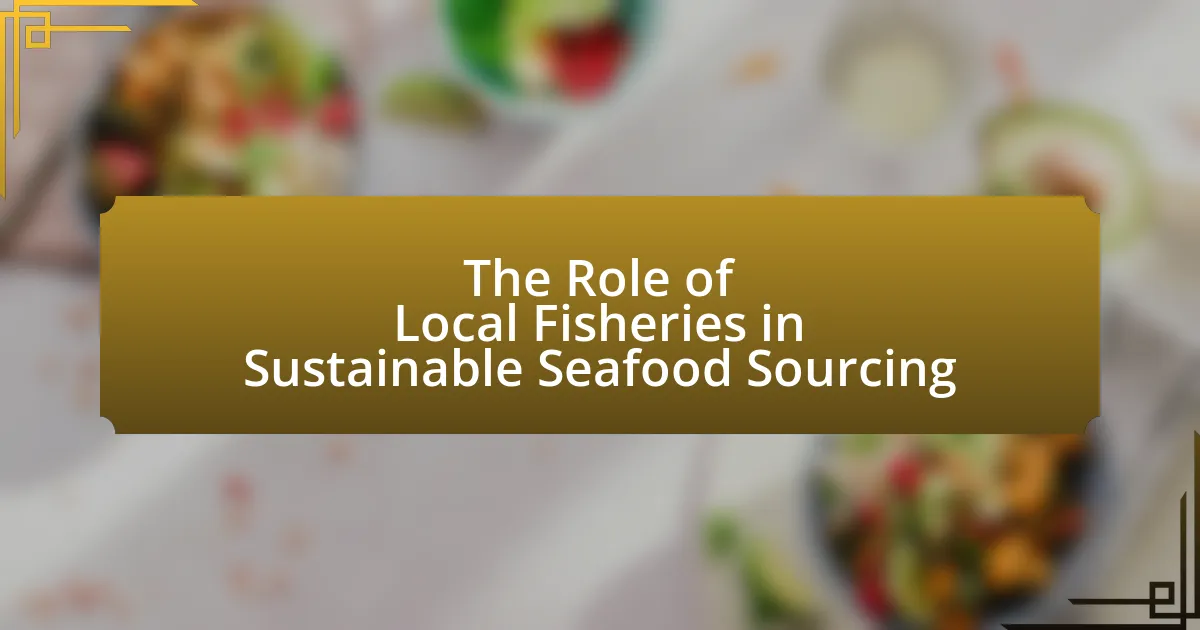Local fisheries are essential for sustainable seafood sourcing, providing fresh, locally-caught fish while supporting environmental health and local economies. They employ responsible fishing practices that minimize overfishing and habitat destruction, contributing to the preservation of marine ecosystems. The article explores how local fisheries implement sustainable practices, the economic benefits they provide to coastal communities, the challenges they face, and the role of consumer awareness in promoting sustainable seafood choices. Key principles of sustainable seafood sourcing, such as maintaining healthy fish populations and supporting local communities, are also discussed, along with best practices for consumers to identify and support sustainable seafood options.

What is the Role of Local Fisheries in Sustainable Seafood Sourcing?
Local fisheries play a crucial role in sustainable seafood sourcing by providing fresh, locally-caught fish that supports both environmental health and local economies. These fisheries often employ practices that minimize overfishing and habitat destruction, contributing to the preservation of marine ecosystems. For instance, according to the Food and Agriculture Organization, small-scale fisheries account for about 50% of the world’s fish catch, emphasizing their significance in maintaining sustainable practices. Additionally, local fisheries often adhere to community-based management strategies, which can lead to more responsible fishing practices and better resource management. This localized approach not only ensures the sustainability of fish populations but also strengthens community resilience and food security.
How do local fisheries contribute to sustainable seafood practices?
Local fisheries contribute to sustainable seafood practices by employing responsible fishing methods that minimize environmental impact and support local ecosystems. These fisheries often adhere to regulations that limit catch sizes and protect breeding populations, ensuring that fish stocks remain healthy and viable. For example, according to the Food and Agriculture Organization, small-scale fisheries are crucial for maintaining biodiversity and can be more sustainable than large industrial operations due to their selective fishing techniques and lower bycatch rates. Additionally, local fisheries often engage in community-based management practices, which foster stewardship of marine resources and promote sustainable consumption among local populations.
What are the key principles of sustainable seafood sourcing?
The key principles of sustainable seafood sourcing include ensuring the health of fish populations, minimizing environmental impact, and supporting local communities. Healthy fish populations are maintained through responsible fishing practices that avoid overfishing and allow for the replenishment of stocks. Minimizing environmental impact involves using methods that reduce bycatch and habitat destruction, such as selective fishing gear and practices that protect marine ecosystems. Supporting local communities is achieved by prioritizing local fisheries, which fosters economic stability and promotes traditional fishing practices that are often more sustainable. These principles are supported by organizations like the Marine Stewardship Council, which sets standards for sustainable fishing and certifies fisheries that meet these criteria.
How do local fisheries implement these principles?
Local fisheries implement sustainable seafood sourcing principles by adopting practices such as selective fishing, habitat protection, and community engagement. Selective fishing techniques, like using specific gear that minimizes bycatch, help maintain fish populations and ecosystem balance. Habitat protection measures, including the establishment of marine protected areas, safeguard critical breeding and feeding grounds for various species. Additionally, local fisheries often engage with their communities to promote awareness and support for sustainable practices, ensuring that fishing activities align with ecological and social goals. These methods collectively contribute to the sustainability of fish stocks and the health of marine ecosystems.
Why are local fisheries important for community economies?
Local fisheries are crucial for community economies because they provide jobs, support local businesses, and contribute to food security. Employment in fisheries often includes not only fishing but also processing, distribution, and retail, which collectively create numerous job opportunities. For instance, in coastal communities, fisheries can account for a significant portion of local employment; in some regions, this figure can exceed 50%. Additionally, local fisheries stimulate the economy by supplying fresh seafood to local markets, which supports restaurants and grocery stores, thereby enhancing local economic activity. Furthermore, they play a vital role in ensuring food security by providing accessible and nutritious food sources to the community, which is essential for maintaining public health and well-being.
What economic benefits do local fisheries provide to coastal communities?
Local fisheries provide significant economic benefits to coastal communities by generating income, creating jobs, and supporting local businesses. These fisheries contribute to the local economy through direct sales of seafood, which can account for a substantial portion of a community’s income; for example, in the United States, commercial fishing generates approximately $200 billion annually. Additionally, local fisheries create employment opportunities not only for fishermen but also for workers in processing, distribution, and retail sectors, thereby enhancing overall community livelihoods. Furthermore, local fisheries stimulate related industries, such as tourism and hospitality, by attracting visitors interested in seafood experiences, which further boosts economic activity in coastal areas.
How do local fisheries support job creation and livelihoods?
Local fisheries support job creation and livelihoods by providing employment opportunities in fishing, processing, and distribution sectors. These fisheries often employ local community members, contributing to economic stability and reducing poverty levels. According to the Food and Agriculture Organization, small-scale fisheries employ approximately 90% of the world’s fishers, highlighting their critical role in sustaining livelihoods. Additionally, local fisheries stimulate related industries such as tourism and retail, further enhancing economic benefits for communities reliant on these resources.
What challenges do local fisheries face in sustainable sourcing?
Local fisheries face significant challenges in sustainable sourcing, primarily due to overfishing, habitat degradation, and regulatory constraints. Overfishing depletes fish stocks faster than they can replenish, threatening the long-term viability of local fisheries. Habitat degradation, caused by pollution and climate change, disrupts marine ecosystems, further complicating sustainable practices. Additionally, regulatory constraints often impose limits that may not align with local needs or realities, making it difficult for fisheries to adapt and implement sustainable methods effectively. These factors collectively hinder the ability of local fisheries to maintain sustainable sourcing practices.
How do overfishing and environmental changes impact local fisheries?
Overfishing and environmental changes significantly diminish local fisheries by depleting fish populations and altering marine ecosystems. Overfishing leads to a decline in target species, disrupting the balance of marine life and reducing biodiversity. For instance, the United Nations Food and Agriculture Organization reported that approximately 34% of global fish stocks are overfished, which directly affects local communities reliant on these resources for their livelihoods. Environmental changes, such as climate change and pollution, further exacerbate these issues by altering habitats, affecting breeding grounds, and shifting fish migration patterns. Research indicates that rising ocean temperatures can lead to a decline in fish stocks, as species may not adapt quickly enough to changing conditions, thereby impacting local fisheries’ sustainability and economic viability.
What regulatory challenges do local fisheries encounter?
Local fisheries encounter regulatory challenges such as compliance with quotas, licensing requirements, and environmental regulations. These regulations often limit the amount of fish that can be caught, which can impact the economic viability of local fisheries. For instance, the Magnuson-Stevens Fishery Conservation and Management Act in the United States imposes strict catch limits to prevent overfishing, which can restrict local fishers’ operations. Additionally, local fisheries must navigate complex permitting processes that can be time-consuming and costly, further complicating their ability to operate sustainably.
How can local fisheries enhance their sustainability efforts?
Local fisheries can enhance their sustainability efforts by implementing responsible fishing practices, such as catch limits and seasonal closures. These measures help prevent overfishing and allow fish populations to recover, ensuring long-term viability. Research indicates that fisheries employing such practices can see a 20% increase in fish stocks over five years, as demonstrated by the success of the Marine Stewardship Council’s certified fisheries. Additionally, local fisheries can engage in habitat restoration projects, which improve ecosystem health and biodiversity, further supporting sustainable fishing.
What role does consumer awareness play in supporting local fisheries?
Consumer awareness plays a crucial role in supporting local fisheries by driving demand for sustainably sourced seafood. When consumers are informed about the benefits of purchasing local fish, such as reduced carbon footprints and support for local economies, they are more likely to choose these products over imported alternatives. Research indicates that consumers who prioritize sustainability are willing to pay a premium for local seafood, which directly benefits local fishers and promotes sustainable fishing practices. For example, a study published in the journal “Marine Policy” found that increased consumer awareness of sustainable seafood options led to a 30% rise in sales for local fisheries, demonstrating the tangible impact of informed consumer choices on the viability of these businesses.
What are the best practices for sourcing seafood sustainably from local fisheries?
The best practices for sourcing seafood sustainably from local fisheries include prioritizing fisheries that are certified by recognized sustainability standards, such as the Marine Stewardship Council (MSC) or the Aquaculture Stewardship Council (ASC). These certifications ensure that the fisheries adhere to practices that maintain fish populations and minimize environmental impact. Additionally, sourcing seafood from fisheries that utilize selective fishing methods, such as traps or lines, reduces bycatch and habitat damage. Engaging with local fishermen and communities fosters transparency and supports local economies, while also ensuring that the seafood is fresh and traceable. Research indicates that sustainable fisheries management can lead to healthier marine ecosystems and long-term economic viability for fishing communities, as highlighted in the report by the Food and Agriculture Organization (FAO) on sustainable fisheries practices.
How can consumers identify sustainable seafood options?
Consumers can identify sustainable seafood options by looking for certifications from reputable organizations such as the Marine Stewardship Council (MSC) or the Aquaculture Stewardship Council (ASC). These certifications indicate that the seafood has been sourced responsibly, adhering to environmental standards that promote fish population health and ecosystem balance. Additionally, consumers can consult guides from organizations like the Monterey Bay Aquarium’s Seafood Watch, which provides recommendations based on sustainability assessments of various seafood products. These resources help consumers make informed choices that support sustainable fishing practices and local fisheries.
What initiatives can local fisheries adopt to improve sustainability?
Local fisheries can adopt initiatives such as implementing catch limits, promoting selective fishing gear, and engaging in habitat restoration to improve sustainability. Catch limits help prevent overfishing by ensuring that fish populations remain healthy and can reproduce effectively. Selective fishing gear reduces bycatch, allowing non-target species to survive and maintain ecological balance. Habitat restoration initiatives, such as replanting seagrass or rebuilding coral reefs, enhance marine ecosystems, supporting biodiversity and the long-term viability of fish stocks. These practices are supported by research indicating that sustainable management leads to increased fish populations and healthier marine environments, as seen in various successful fisheries worldwide.

Leave a Reply